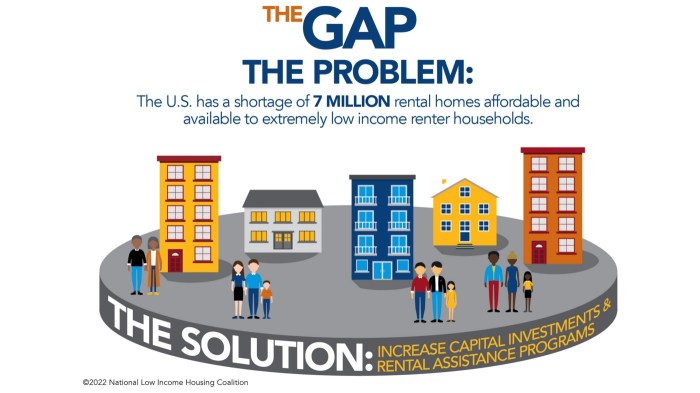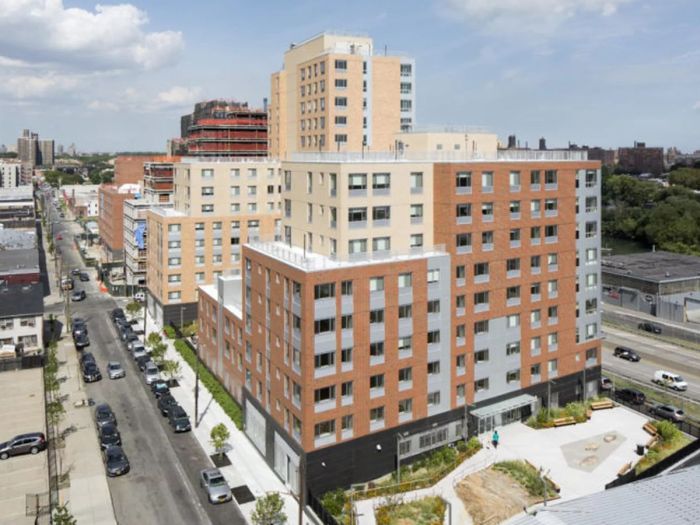Low Income Housing to Rent A Comprehensive Guide
Understanding Low-Income Housing to Rent
Low income housing to rent – Access to affordable housing is a critical social determinant of health and well-being. This article provides an overview of low-income housing to rent, encompassing its definition, availability, application processes, costs, and tenant rights.
Defining “Low-Income Housing to Rent”
Low-income housing to rent refers to rental units specifically designed for individuals and families whose income falls below a certain threshold. This threshold is determined by various factors, including local area median income (AMI) and household size. The definition and criteria can vary significantly depending on the region and the specific program involved.
Income Limits and Housing Types
Income limits for low-income housing are typically set as a percentage of the area median income (AMI). For example, a unit might be designated for households earning 30% to 80% of the AMI. These percentages vary regionally and by program. Examples include: A family of four in Los Angeles might qualify with an income below $80,000, while a similar family in rural Kansas might qualify with a much lower income.
The types of housing included are diverse. They range from single-family homes and townhouses to apartment buildings, often with varying amenities such as on-site laundry facilities, playgrounds, and community centers. Some may be newly constructed, while others are renovated existing properties.
Legal and Regulatory Frameworks
Various legal and regulatory frameworks govern low-income rental housing at local, state, and federal levels. These regulations aim to ensure fair housing practices, protect tenant rights, and maintain housing quality. The specifics differ widely.
| Region | Legislation | Income Limits | Tenant Rights |
|---|---|---|---|
| United States (Federal) | Fair Housing Act, Section 8 Housing Choice Voucher Program | Varies by region and household size (percentage of AMI) | Protection against discrimination, right to a habitable dwelling, right to privacy |
| California | California Tenant Protection Act, various local ordinances | Varies by county and city (percentage of AMI) | Strong protections against eviction, right to repair, rent control in some areas |
| New York | New York State Tenant Protection Act, rent stabilization laws in NYC | Varies by region and program (percentage of AMI) | Significant protections against eviction, rent regulation in many areas |
Availability and Location of Low-Income Rental Housing
The availability of low-income rental housing is unevenly distributed geographically, influenced by several key factors. A map illustrating this would show high concentrations in urban centers, particularly near public transportation, and lower densities in rural areas and suburban communities.
Geographic Distribution and Influencing Factors
Several factors influence the availability of low-income housing. Zoning regulations often restrict the construction of multi-family dwellings in certain areas, limiting the supply of affordable units. Funding limitations for affordable housing programs can also constrain the development of new units. High market demand in desirable locations further exacerbates the scarcity of affordable rental options.
Urban vs. Rural Availability
- Urban Areas: Higher concentration of low-income housing units, often near public transportation and employment centers, but also facing higher competition and potentially higher rents due to demand.
- Rural Areas: Lower concentration of low-income housing, often with limited access to transportation and employment opportunities, but potentially lower rents due to lower demand.
Application Process and Tenant Selection
Securing low-income rental housing often involves a competitive application process.
Application Process
- Locate available units through online listings, local housing authorities, or community organizations.
- Complete a comprehensive application, including income verification, background checks, and references.
- Submit the application and supporting documents.
- Wait for processing, which may involve a lengthy waiting list.
- If approved, sign a lease agreement.
Tenant Selection Criteria and Challenges

Source: oneneighborhoodbuilders.org
Tenant selection typically involves reviewing applications, conducting background checks (including credit and criminal history), and verifying income. Waiting lists are common, and applicants often face challenges such as lengthy wait times, stringent eligibility requirements, and competition for limited units.
Rental Costs and Affordability
The cost of low-income housing varies significantly by location and program. However, even with subsidies, affordability remains a significant challenge.
Rental Cost Comparison
| Location | Low-Income Rent | Market Rate Rent | Percentage Difference |
|---|---|---|---|
| New York City | $1,500 (example) | $3,000 (example) | 50% |
| Los Angeles | $1,800 (example) | $2,700 (example) | 33% |
| Rural Kansas | $800 (example) | $1,200 (example) | 33% |
Impact of Subsidies and Affordability Challenges
Government subsidies and rental assistance programs significantly impact affordability by reducing tenant costs and increasing housing availability. However, rising inflation, increasing property values, and limited funding often outweigh the impact of these programs, contributing to persistent affordability challenges.
Tenant Rights and Responsibilities
Tenants in low-income housing have specific rights and responsibilities protected by law.
Tenant Rights and Responsibilities
- Rights: Right to a safe and habitable dwelling, protection against discrimination, right to privacy, right to quiet enjoyment.
- Responsibilities: Paying rent on time, maintaining the property in a reasonable condition, adhering to lease terms.
Addressing Tenant Complaints and Disputes, Low income housing to rent

Source: vox-cdn.com
Procedures for addressing tenant complaints and disputes vary by jurisdiction, but often involve mediation, arbitration, or legal action. Landlord-tenant laws provide a framework for resolving conflicts and protecting tenant rights.
Clarifying Questions: Low Income Housing To Rent
What documents are typically required for a low-income housing application?
Applications generally require proof of income, identification, and sometimes rental history. Specific requirements vary by location and program.
Securing affordable rental housing can be a challenge, especially for individuals and families with limited incomes. Finding suitable low-income housing options often requires extensive searching. For those seeking more upscale options, however, you might explore the market for houses to rent in Edina MN , which offers a different range of properties and price points. Ultimately, the search for low-income housing to rent necessitates careful consideration of location, amenities, and budget.
Can I be denied housing even if I meet the income requirements?
Yes, background checks and rental history are often considered. Evictions or criminal records may impact eligibility.
What happens if my income increases while living in low-income housing?
Most programs have income limits. An increase above the limit may require you to leave the program or pay a higher rent.
How can I find low-income housing in my area?
Contact your local housing authority or search online databases for affordable housing listings in your region.




















